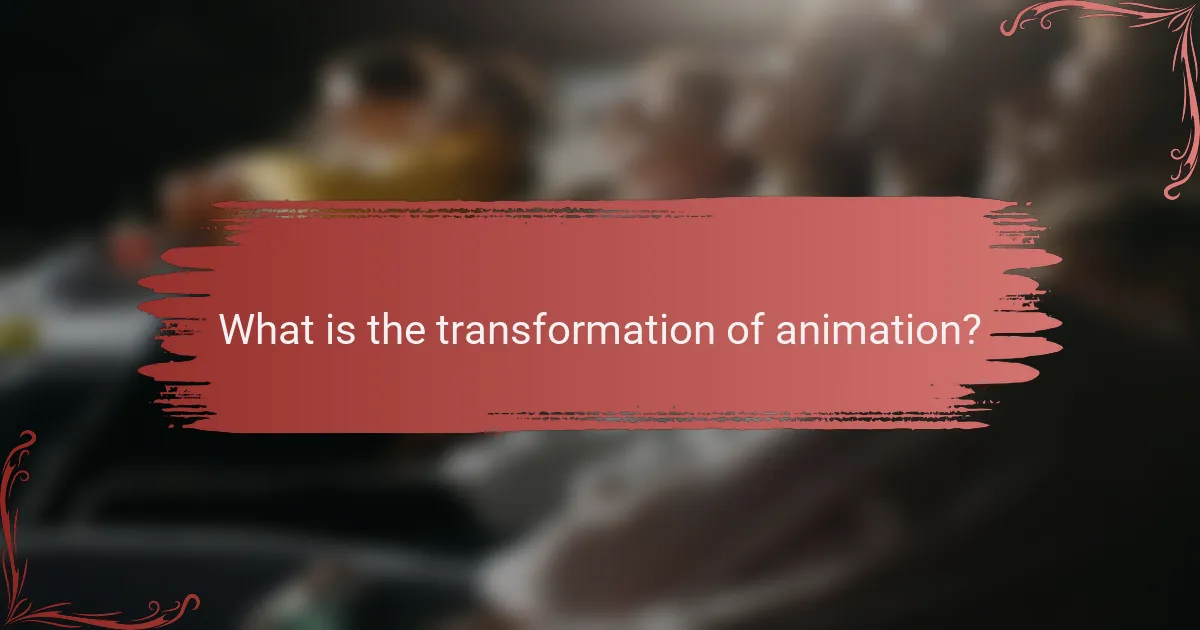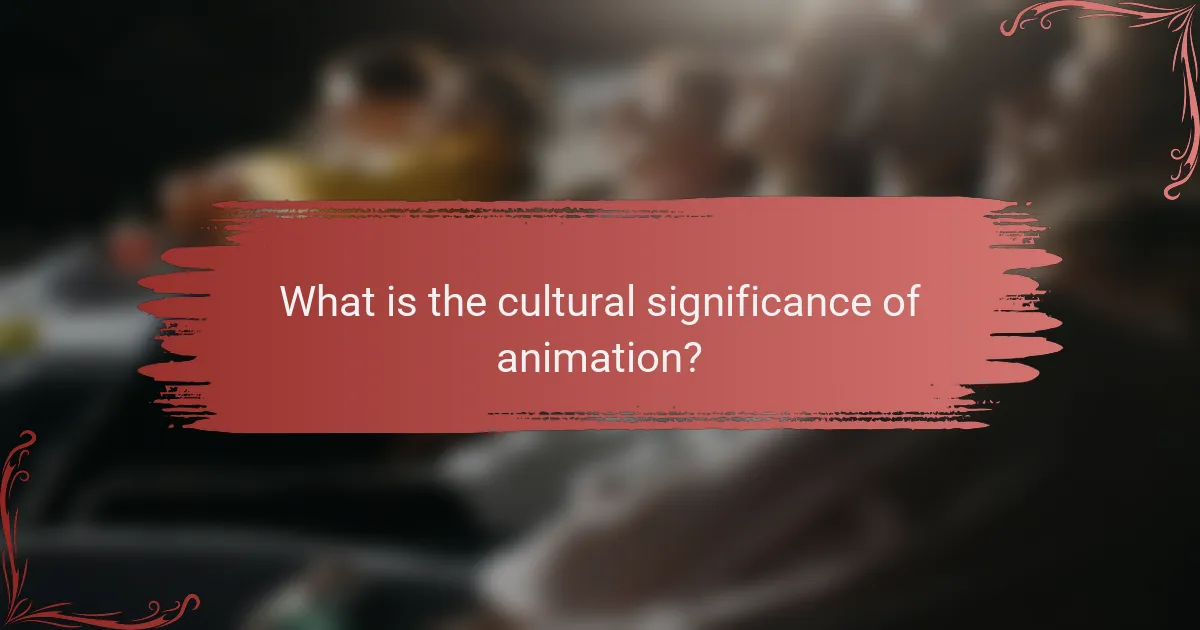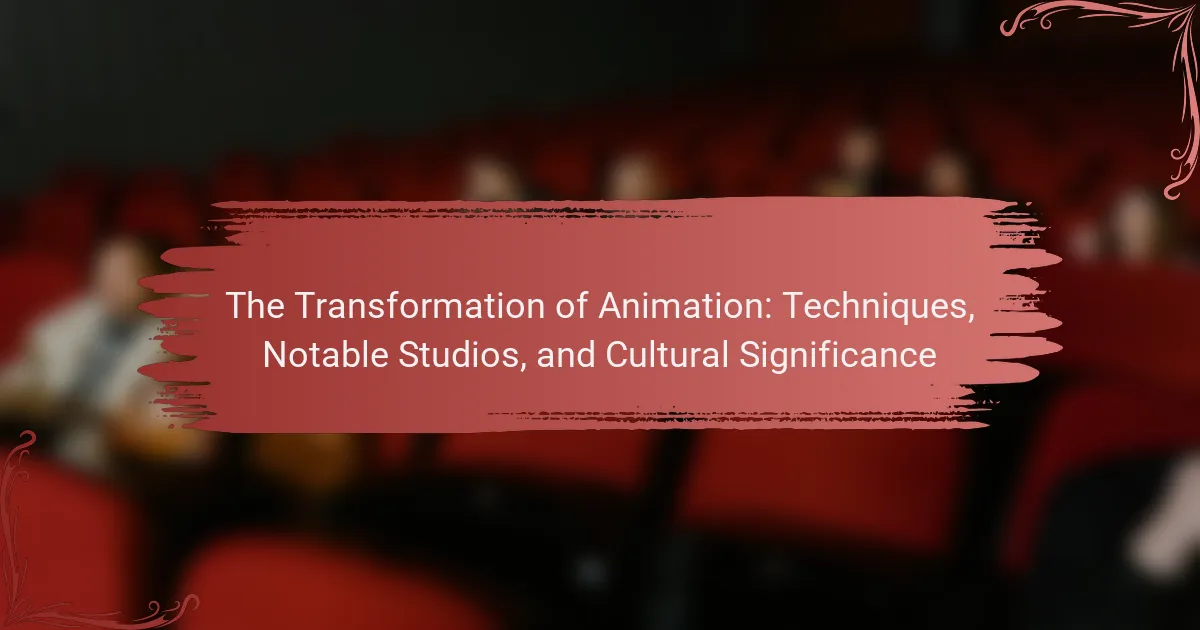The transformation of animation encompasses the evolution of animation techniques and styles from traditional hand-drawn methods to advanced computer-generated imagery (CGI) and 3D animation. Notable studios such as Walt Disney Animation Studios, Pixar Animation Studios, Studio Ghibli, and DreamWorks Animation have significantly influenced this evolution, setting new standards for visual quality and storytelling. The cultural significance of animation is profound, as it reflects societal values and narratives, fosters creativity, and promotes cultural exchange. This article explores the key developments in animation techniques, highlights the contributions of major studios, and examines the cultural impact of animated films across different societies.

What is the transformation of animation?
The transformation of animation refers to the evolution of animation techniques and styles over time. Initially, animation was created using hand-drawn images on film. This method, known as traditional animation, dominated the early 20th century. With technological advancements, computer-generated imagery (CGI) emerged in the late 20th century. CGI allowed for more realistic and complex animations. The introduction of 3D animation further revolutionized the industry, enabling dynamic storytelling. Notable studios, such as Pixar and DreamWorks, played significant roles in this transformation. Their innovations set new standards for visual quality and narrative depth. The cultural significance of animation has also evolved, influencing various media and art forms globally.
How has animation evolved over the decades?
Animation has evolved significantly over the decades. In the early 20th century, animation began with hand-drawn techniques, exemplified by short films like “Gertie the Dinosaur” in 1914. The introduction of synchronized sound in “Steamboat Willie” in 1928 marked a major innovation. The 1930s and 1940s saw the rise of feature-length animations, with Disney’s “Snow White and the Seven Dwarfs” debuting in 1937. The 1960s introduced television animation, leading to series like “The Flintstones.”
The 1990s brought computer-generated imagery (CGI) into mainstream animation, starting with films like “Toy Story” in 1995. The 2000s further advanced CGI techniques, allowing for more realistic animations. Streaming platforms in the 2010s transformed distribution, making animation more accessible. Today, animation continues to blend traditional and digital methods, expanding into virtual reality and interactive formats.
What were the key milestones in the history of animation?
The key milestones in the history of animation include the creation of the first animated film, “Gertie the Dinosaur,” by Winsor McCay in 1914. This film showcased character animation and established storytelling in animation. The introduction of sound in “Steamboat Willie” in 1928 marked the first synchronized sound cartoon, created by Walt Disney. The development of Technicolor in the 1930s allowed animations like “Snow White and the Seven Dwarfs” in 1937 to utilize vibrant colors. The 1960s saw the rise of television animation, with shows like “The Flintstones” becoming popular. The 1990s introduced CGI animation, exemplified by “Toy Story” in 1995, which was the first entirely computer-animated feature film. The advent of digital animation techniques in the 2000s revolutionized the industry, allowing for more complex and visually stunning animations. Each of these milestones significantly shaped the evolution of animation as an art form and entertainment medium.
How did technological advancements influence animation techniques?
Technological advancements significantly influenced animation techniques by introducing new tools and methods. The transition from hand-drawn frames to computer-generated imagery (CGI) revolutionized the industry. For instance, Pixar’s use of CGI in “Toy Story” in 1995 set a new standard for animation quality. Software like Adobe Animate and Blender provided animators with powerful capabilities for creating complex scenes. Additionally, advancements in motion capture technology allowed for more realistic character movements. The integration of 3D modeling also enabled more dynamic storytelling. These innovations led to a broader range of artistic expression in animation. Overall, technology reshaped how animators create and present their work.
What are the different techniques used in animation?
Animation techniques include traditional animation, 2D animation, 3D animation, stop-motion animation, and motion graphics. Traditional animation involves hand-drawn images that create the illusion of movement. 2D animation uses digital tools to produce flat images. 3D animation creates lifelike characters and environments using computer-generated imagery. Stop-motion animation involves photographing physical objects frame by frame. Motion graphics combine graphic design and animation for visual storytelling. Each technique has unique characteristics that contribute to the animation industry.
What are the primary forms of animation?
The primary forms of animation include traditional animation, computer-generated imagery (CGI), stop-motion, and 2D animation. Traditional animation involves hand-drawn frames, creating the illusion of movement. CGI uses digital tools to create three-dimensional animations. Stop-motion involves photographing physical objects in small increments to animate them. 2D animation focuses on creating images in a two-dimensional space. Each form has unique techniques and applications in the animation industry. Traditional animation dates back to the early 20th century, while CGI emerged with advancements in technology in the late 20th century.
How do traditional techniques differ from modern digital methods?
Traditional techniques rely on hand-drawn frames, while modern digital methods utilize software for animation. Traditional animation often involves creating each frame by hand, which can be time-consuming. In contrast, digital animation allows for quicker iterations and adjustments. Traditional methods require physical materials like paper and paint, whereas digital techniques use graphics tablets and animation software. The frame rate in traditional animation is typically lower due to manual processes, while digital methods can achieve higher frame rates effortlessly. Traditional animation often has a distinct, tactile quality, while digital animation offers a smoother, more polished finish. Historical examples include Disney’s early hand-drawn works compared to contemporary CGI films like “Toy Story.”

Which studios have significantly impacted animation?
Walt Disney Animation Studios has significantly impacted animation. Founded in 1923, it pioneered feature-length animated films. “Snow White and the Seven Dwarfs,” released in 1937, was the first full-length animated feature. This film set a new standard for storytelling and animation quality. Pixar Animation Studios revolutionized computer-generated imagery with “Toy Story” in 1995. This was the first entirely computer-animated feature film. Studio Ghibli, established in 1985, is renowned for its artistic storytelling and unique animation style. Its films, like “Spirited Away,” have won numerous awards and critical acclaim. DreamWorks Animation introduced innovative techniques with films like “Shrek,” which combined traditional and computer animation. Each of these studios has left a lasting legacy in the animation industry.
What are some notable animation studios throughout history?
Walt Disney Animation Studios, founded in 1923, is a pioneering animation studio known for its classic films. It created iconic works like “Snow White and the Seven Dwarfs,” the first full-length animated feature. Warner Bros. Animation, established in 1933, is recognized for its influential Looney Tunes series. Studio Ghibli, founded in 1985 by Hayao Miyazaki and Isao Takahata, is acclaimed for its artistic storytelling in films like “Spirited Away.” Pixar Animation Studios, created in 1986, revolutionized animation with its use of computer-generated imagery, starting with “Toy Story” in 1995. DreamWorks Animation, established in 1994, gained fame with franchises like “Shrek” and “Kung Fu Panda.” These studios have significantly shaped the animation industry and influenced global culture.
How did Disney revolutionize the animation industry?
Disney revolutionized the animation industry by introducing synchronized sound and full-length animated features. The release of “Steamboat Willie” in 1928 marked the first successful use of synchronized sound in animation. This innovation captivated audiences and set a new standard for animated films. Disney further transformed the industry with “Snow White and the Seven Dwarfs” in 1937, the first-ever full-length animated feature. This film demonstrated the commercial viability of animated storytelling. Disney’s use of Technicolor also enhanced visual appeal, making animations more vibrant. Additionally, Disney pioneered character development and emotional storytelling, creating relatable characters. These advancements established animation as a respected art form and influenced future studios.
What contributions did Studio Ghibli make to global animation?
Studio Ghibli significantly influenced global animation through its unique storytelling and artistic techniques. The studio popularized hand-drawn animation, emphasizing detailed backgrounds and fluid character movements. Its films often explore complex themes, such as environmentalism and the human condition. Notable works like “Spirited Away” won international acclaim, including an Academy Award for Best Animated Feature in 2003. This recognition helped elevate the status of animated films worldwide. Studio Ghibli’s emphasis on character development and emotional depth set new standards in the industry. The studio has inspired countless animators and filmmakers globally, fostering a greater appreciation for animation as an art form.
How do independent studios influence the animation landscape?
Independent studios significantly influence the animation landscape by fostering innovation and diversity. They often explore unconventional themes and styles that mainstream studios may overlook. For instance, films like “The Secret of Kells” and “Persepolis” showcase unique artistic visions. Independent studios frequently take creative risks, leading to groundbreaking storytelling techniques. This approach encourages larger studios to experiment with their own projects. Moreover, independent animations often resonate with niche audiences, expanding the market. The success of independent films can challenge industry norms and inspire future creators. Overall, independent studios play a crucial role in shaping the evolution of animated content.
What are some examples of successful independent animated films?
Some examples of successful independent animated films include “The Secret of Kells,” “Persepolis,” “Song of the Sea,” and “Anomalisa.” “The Secret of Kells” received an Academy Award nomination for Best Animated Feature in 2010. “Persepolis,” based on Marjane Satrapi’s graphic novel, also garnered an Oscar nomination in 2008. “Song of the Sea,” directed by Tomm Moore, was nominated for an Academy Award in 2015. “Anomalisa,” created by Charlie Kaufman and Duke Johnson, was nominated for Best Animated Feature at the 2016 Oscars. These films are recognized for their unique storytelling and artistic styles, contributing significantly to the independent animation landscape.
How do indie studios challenge mainstream animation conventions?
Indie studios challenge mainstream animation conventions by embracing unique storytelling and artistic styles. They often prioritize personal narratives and experimental techniques over commercial viability. This results in diverse content that reflects varied cultural perspectives. For example, films like “The Secret of Kells” showcase intricate hand-drawn animation. Indie studios also explore unconventional themes and genres, breaking away from typical family-friendly formats. This approach fosters innovation and pushes the boundaries of visual storytelling. Notably, films such as “Persepolis” and “Waltz with Bashir” have received critical acclaim for their bold narratives and artistic choices.

What is the cultural significance of animation?
Animation holds significant cultural value as it reflects societal values and narratives. It serves as a medium for storytelling across various cultures. Animation can convey complex themes in an accessible manner. It often influences and shapes public perceptions on social issues. For instance, films like “Spirited Away” highlight Japanese culture and folklore. Animation also fosters creativity and innovation in the arts. Furthermore, it bridges generational gaps, appealing to both children and adults. The global reach of animated films promotes cultural exchange and understanding.
How does animation reflect societal values and issues?
Animation reflects societal values and issues by portraying cultural norms and addressing contemporary topics. It serves as a mirror to society, often highlighting social justice, environmental concerns, and political commentary. For instance, films like “Zootopia” address prejudice and discrimination, showcasing the importance of diversity. Similarly, “Wall-E” raises awareness about environmental degradation and consumerism. Animation can also challenge stereotypes, as seen in “The Princess and the Frog,” which features a strong Black female lead. Furthermore, animated series like “The Simpsons” critique societal behaviors and political landscapes. This medium allows for complex narratives that resonate with audiences, making it a powerful tool for social commentary.
What themes are commonly explored in animated works?
Common themes in animated works include friendship, adventure, and self-discovery. Many animated films explore the journey of characters forming bonds and overcoming obstacles together. Adventure themes often involve quests or journeys that lead to personal growth. Self-discovery is a prevalent theme, where characters learn about their identity and purpose. Other themes include family dynamics, love, and the battle between good and evil. These themes resonate with audiences of all ages, making animated works relatable and impactful. For instance, films like “Toy Story” and “The Lion King” exemplify these themes through their narratives and character arcs.
How does animation appeal to diverse audiences across cultures?
Animation appeals to diverse audiences across cultures through universal themes and relatable characters. It often conveys emotions like joy, sadness, and friendship that resonate globally. Visual storytelling transcends language barriers, making it accessible to various demographics. Cultural references are sometimes adapted, allowing local audiences to connect deeply. For instance, Studio Ghibli’s films incorporate Japanese folklore while appealing to international viewers. Additionally, animation styles vary, offering something for everyone, from traditional hand-drawn to modern CGI. The global popularity of animated franchises like Disney and Pixar highlights this cultural reach. Animation festivals worldwide celebrate diverse works, promoting cross-cultural appreciation.
What role does animation play in education and communication?
Animation serves as a powerful tool in education and communication. It enhances understanding by visually representing complex concepts. Studies show that 65% of people are visual learners. Animation captures attention and improves retention of information. It simplifies difficult subjects, making them more accessible. Animated content can engage students in interactive learning experiences. This method promotes creativity and critical thinking skills. Additionally, animation can bridge language barriers, making communication universal.
How is animation used as a tool for storytelling and engagement?
Animation serves as a powerful tool for storytelling and engagement by visually conveying complex narratives. It creates immersive experiences that capture audience attention. Through vibrant visuals and dynamic movement, animation enhances emotional connection. Characters can express a wide range of emotions, making stories relatable. Animation also allows for imaginative worlds that transcend reality. This creativity fosters engagement by inviting viewers into unique experiences. Research indicates that animated content increases retention rates among audiences, enhancing message delivery. For example, a study by the University of California found that animated videos improve information recall by up to 65%. Thus, animation effectively combines art and storytelling to engage audiences deeply.
What are the benefits of using animation in educational contexts?
Animation enhances educational contexts by improving engagement and retention. It captures students’ attention more effectively than static images or text. Research shows that visual learning can increase information retention by up to 65%. Animation simplifies complex concepts through visual storytelling. It allows for step-by-step explanations that facilitate understanding. Furthermore, animated content can cater to diverse learning styles, accommodating visual and auditory learners. Studies indicate that students are more likely to recall information presented through animation compared to traditional methods. Overall, animation serves as a powerful tool in education, making learning more interactive and effective.
What are the future trends in animation?
Future trends in animation include increased use of virtual reality (VR) and augmented reality (AR). These technologies enhance viewer immersion and interaction. The rise of artificial intelligence (AI) in animation is also notable. AI can automate processes like in-betweening and character rigging, saving time and resources. Furthermore, 3D animation continues to evolve with advancements in rendering technology. Real-time rendering allows for quicker production cycles and more dynamic visuals. Additionally, diverse storytelling is becoming a focus. Animation is increasingly used to address social issues and represent underrepresented voices. The global demand for animation content is growing, fueled by streaming platforms. This trend encourages studios to produce more varied and innovative content.
How is technology shaping the future of animation?
Technology is significantly shaping the future of animation through advancements in software and hardware. High-performance rendering engines enable more realistic visuals. Artificial intelligence is streamlining animation processes, reducing production time. Virtual reality is creating immersive experiences for audiences. Motion capture technology enhances character realism and fluidity. Cloud-based collaboration tools facilitate remote teamwork among animators. These innovations are making animation more accessible to independent creators. The animation industry is evolving rapidly, driven by these technological changes.
What emerging styles and techniques are gaining popularity?
3D animation techniques are gaining popularity in the animation industry. These techniques allow for more realistic character movements and environments. Additionally, virtual reality (VR) animation is emerging as a new frontier. VR provides immersive experiences that engage audiences in novel ways. Another trend is the use of hand-drawn animation combined with digital tools. This hybrid approach creates a unique aesthetic that appeals to modern viewers. Motion capture technology is also becoming more prevalent. It enhances the realism of animated characters by capturing human movements. Furthermore, the incorporation of artificial intelligence (AI) in animation workflows is on the rise. AI can automate repetitive tasks, allowing artists to focus on creative aspects. These trends reflect the industry’s shift towards innovation and audience engagement.
What are some best practices for aspiring animators?
Aspiring animators should focus on developing a strong foundation in animation principles. Mastering the 12 principles of animation, such as squash and stretch, timing, and anticipation, is crucial. Regular practice is essential; animators should create short animations consistently to hone their skills. Studying anatomy and movement helps in creating realistic animations.
Additionally, aspiring animators should seek feedback from peers and mentors to improve their work. Networking within the animation community can open up opportunities for collaboration and learning. Learning software tools like Adobe Animate, Blender, or Maya is necessary for modern animation.
Finally, building a diverse portfolio showcasing various styles and techniques is important for attracting potential employers. These practices align with industry standards and enhance an animator’s skill set.
The transformation of animation encompasses the evolution of techniques and styles from traditional hand-drawn methods to modern computer-generated imagery (CGI). This article explores key milestones in animation history, significant technological advancements, and the impact of notable studios such as Disney, Pixar, and Studio Ghibli. It also examines the cultural significance of animation, its role in education and communication, and emerging trends shaping the future of the industry. Additionally, the article highlights the contributions of independent studios and the importance of diverse storytelling in animation.
